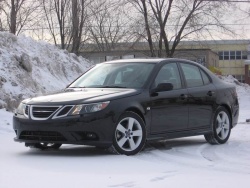 2008 Saab 9-3 2.0T. Click image to enlarge |
|
Competitors Buyers’ Guide: 2008 Acura TSX Buyer’s Guide: 2008 Audi A4 Buyer’s Guide: 2008 BMW 3 Series Buyer’s Guide: 2008 Infiniti G35 Buyer’s Guide: 2008 Jaguar X-Type Buyer’s Guide: 2008 Lexus IS 250 Buyer’s Guide: 2008 Mercedes-Benz C-Class Buyer’s Guide: 2008 Volvo S40 Manufacturer’s web site |
Review and photos by Chris Chase
Discuss this story in the forum at CarTalkCanada
Find this vehicle in Autos’s Classified Ads
Photo Gallery:
2008 Saab 9-3
Ottawa, Ontario – When we test new cars, the automakers typically loan them to us for a week. In theory, this is enough time to find all the positive and negative aspects of a vehicle, and in practice, it usually is too. But when it comes to Saab, I could seemingly spend forever pondering this Swedish brand’s raison d’etre since being acquired by General Motors.
It used to be that Saab was one of the quirkiest automotive brands around, from the almost-upright windshield of the original 900, to the emergency brake that acted on the front wheels and the ignition switch found between the front seats.
It bugs me that Saab has lost a lot of the weirdness that used to be the brand’s hallmark. The 9-3’s mild redesign for 2008 helps a little. Check out the more pronounced grille, which emphasizes the three-pod look that can be traced way back to the 1960s. The “clamshell” hood is another design feature reclaimed from decades past. However, I have my doubts, as you might, that these minor changes are enough to bring Saab back to its days of building cars that stood out, if only for their oddities.
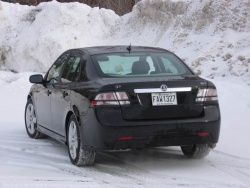 2008 Saab 9-3 2.0T. Click image to enlarge |
Taken on its own, there’s a lot to like about the 9-3. It drives well, going over the road smoothly and quietly – maybe too quietly: the engine is practically inaudible at lower speeds, making it tough to accelerate hard in lower gears without banging up against the rev limiter. The tall first, second and third gear ratios suggest that blasting away from stoplights isn’t this car’s purpose.
Even so, the base 2.0-litre turbocharged four-cylinder motor is an eager one. Torque is generous at low revs, and the engine seems happy to rev right to its 6,500 rpm redline, making power all the way. And this engine reminds me why I like smaller turbocharged motors: that strong power is accompanied by decent fuel consumption when you stay off the gas. According to my tester’s on-board computer, the car averaged just over 11.5 L/100 km in a mix of highway and mostly city driving, including some very cold weather and a couple days’ worth of light snow.
That snow, while admittedly nothing like the massive hits we’ve received throughout this Ottawa winter, did little to faze the 9-3, despite it being shod with all-season tires. The slippery conditions meant it was easy to invoke the standard traction and stability control system, but its operation is fairly gentle, so that the only obvious clue that it’s at work is the telltale light that appears on the instrument panel when it does cut in.
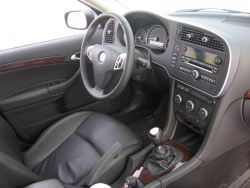 2008 Saab 9-3 2.0T. Click image to enlarge |
My four-cylinder tester had the standard six-speed manual transmission. The last 9-3 I tested – a 2007 Cabriolet – paired the four-banger with the optional five-speed automatic transmission, an unhappy union if ever I’d seen one. The engine’s noticeable turbo lag conspires with the auto-box to take all the fun out of the drive.
Opting to shift for yourself is mostly rewarding. While the turbo lag still makes itself known, it’s much less apparent with the manual. The issue is instead with the shifter itself. I realize winter often brings out the worst in a car, but when the 9-3 is cold, the shifter really hates its job, moving reluctantly, especially from first to second gear. It gets better when the car’s warm, but never gets great, partly thanks to long-ish shift throws, and a connection between the shifter and transmission that feels too rubber band-y to make shifting truly fun.
On the other hand, the clutch is lovely, with smooth take-up and a nicely-weighted pedal. I liked the brakes too; aside from some grabbiness upon their initial bite, they’re easy to modulate and pedal feel is pretty good.
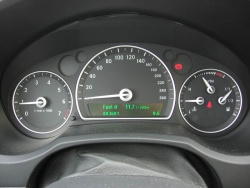 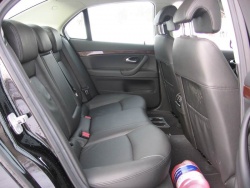 2008 Saab 9-3 2.0T. Click image to enlarge |
My biggest beef with the foot controls is that with bulky winter boots on, there’s not a lot of room between the brake pedal and centre console. It’s easy for oversized footwear to get hung up on the brake pedal when moving to the gas. Thankfully, a slimmer pair of boots solved the problem, but never before has a car dictated what footwear I should don before leaving the house.
Over the road, the 9-3 certainly feels solid, but less so than some of its competitors. The ride is softer, too, than what you’d expect from a European car, with some unexpected float over larger bumps.
When the roads weren’t snowy, they were cold, so testing at-the-limit handling, particularly without winter tires, was difficult. The chassis seems eager enough to turn in, however, and the steering offers some feedback as to the conversation happening between the pavement and the front wheels.
The front seats are comfortable, but less coddling than a Volvo’s (for example) and with the same lack of lateral support. In back, the outboard seats are comfortable too, with decent head and legroom for average-sized riders, and lots of toe room under the front seats. Forget about the middle position, though. Trunk space is great, thanks to the large opening and the cargo area’s squared-off shape. Fold the back seat down, and you get a nice, big opening, too.
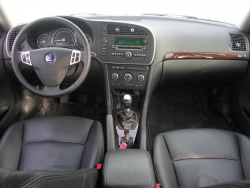 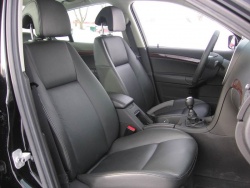 2008 Saab 9-3 2.0T. Click image to enlarge |
The 9-3’s dash is a refreshing alternative to the overly tech-heavy instrument panels in many European cars. Controls for the stereo and climate control system are simple and easy to figure out. Fit and finish are both good, and the interior generally feels like quality, but the matte black plastic on the face of the dash feels just a touch chintzy.
While I’m griping, a dash-mounted cancel button for the traction control system would be welcome. Turning the system off requires the driver to scroll through a lengthy list of controls via a display in the gauge cluster.
However, that same list also grants access to one of my favourite features of this car: the choice to have the front seat heaters and rear defroster turn on automatically in cold weather.
My 9-3 2.0T tester carried a starting price of just under $36,000. Seventeen-inch alloy wheels and an upgraded stereo (the package includes a six-disc CD changer, surround sound and eleven speakers, as well as satellite radio) each add $995 to the bottom line, while a Premium Package (Xenon headlights, fog lamps, eight-way power driver’s seat, wood-trimmed interior and rear parking assist) adds $1,590 and a sunroof costs an extra $1,600. With freight and A/C tax in, the total comes to $42,630.
I could get into how the 9-3 compares to its European competitors, but I won’t, because the 9-3’s biggest problem isn’t anything from Europe. The problem, and the biggest challenge for anyone trying to justify buying a 9-3, comes instead from another GM product.
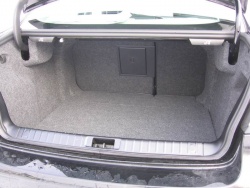 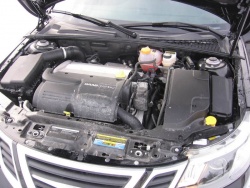 2008 Saab 9-3 2.0T. Click image to enlarge |
For about $2,200 more than my Saab tester was worth, you can kit out a base Cadillac CTS with most of the stuff the 9-3 had (plus a couple things the Saab didn’t have). Plus, you get six-cylinder power (and more of it), rear-wheel drive (more appealing to many enthusiasts), more interior space and a badge that actually connotes luxury in a car that blows the 9-3 away in how it goes down the road.
And then there’s the issue that for about $10,000 less than the 9-3, you can buy what is essentially the same car, albeit with different powertrains, from Chevrolet (Malibu), Pontiac (G6) and Saturn (Aura) dealers. Never mind, too, that a Volkswagen Passat 2.0T carries a very similar powertrain as the base 9-3, and can be outfitted similarly to my Saab tester for less than $37,000.
Indeed, taken on its own, the 9-3 is a wonderful car; a week behind the wheel is more than enough time to figure that out. As much as I like the 9-3, though, one week later I was no closer to knowing why Saab even still matters.
|
Pricing: 2008 Saab 9-3 2.0T
Base price: $36,000 A/C tax: $100
Specifications
Related articles on Autos
First Drives Test Drives Day-by-Day Reviews
Competitors
Manufacturer’s web site
Crash test results
|











